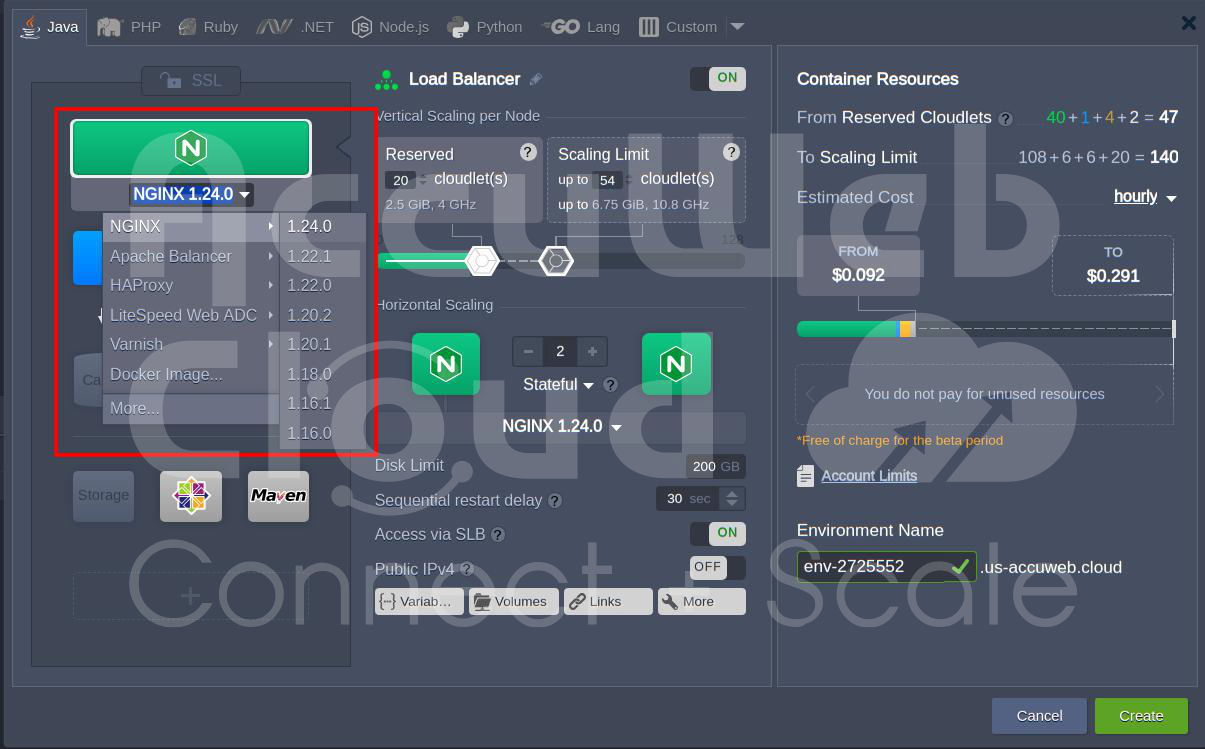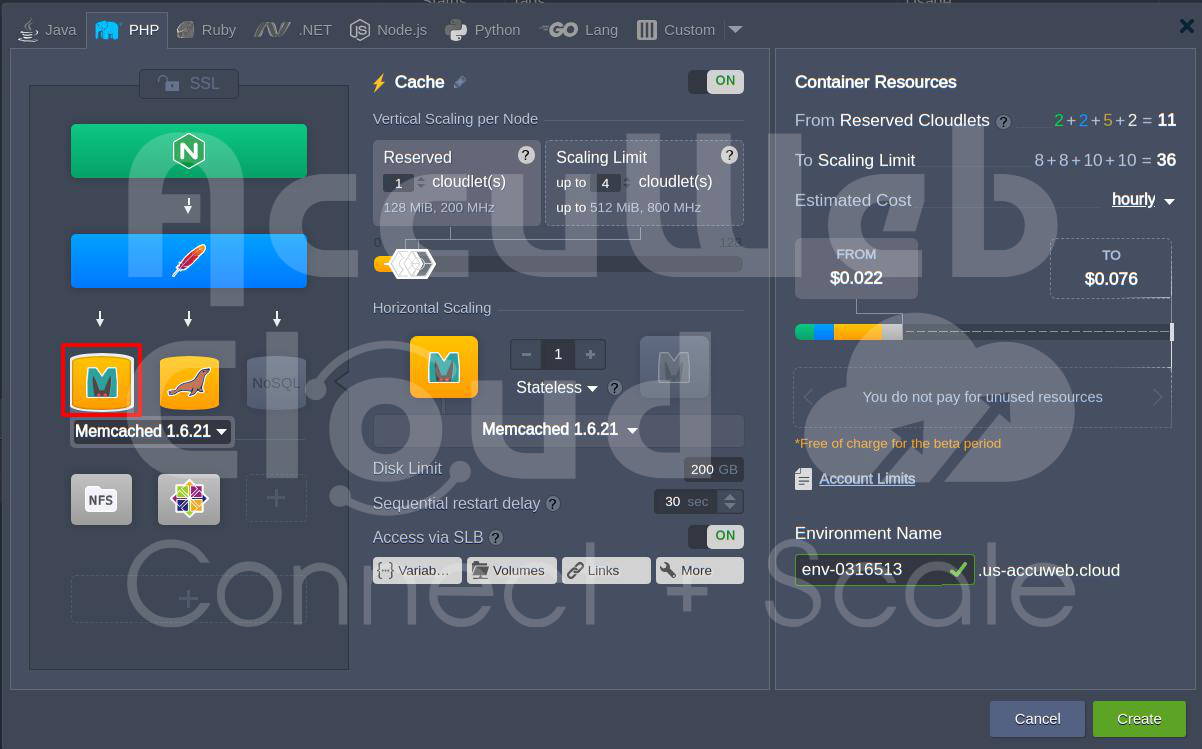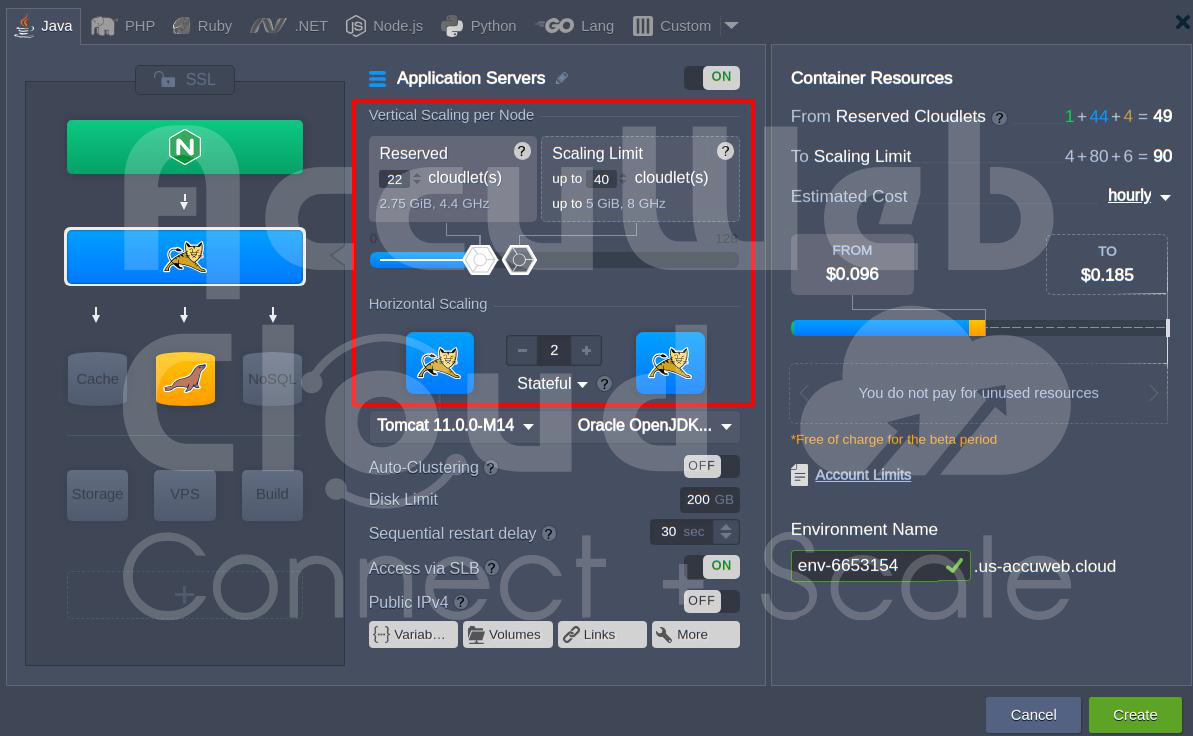How to Improve Website Performance with Cloud Hosting?
Cloud hosting, with its scalable and efficient infrastructure, offers a solid foundation for optimizing website speed and reliability. In this comprehensive guide, we’ll explore various strategies of How to Improve Website Performance using cloud hosting and focusing on key elements such as server location and web server choice and configuration and PHP version and MySQL fork and HTTP protocol and the integration of Content Delivery Network (CDN).
Tips on How to Improve Website Performance with Cloud Hosting
1. Choose a Nearby Datacenter Location:
Optimize server response times by selecting a data center location that is geographically close to your target audience. Lower latency ensures faster loading times for users. Accuweb.cloud offers four server locations:
- Los Angeles, USA
- Chennai, India
- Frankfurt, Germany
- New York, USA
2. Choose a High Performance Web Server:
The choice of a web server significantly impacts website speed. Apache is a common option and NGINX and LiteSpeed are superior choices for high traffic websites. NGINX excels at simplicity and making it ideal for straightforward sites and whereas LiteSpeed offers easy accessible features and a WordPress cache plugin, providing a substantial advantage. By carefully evaluating these considerations you can make an informed decision and choose a high performance web server that aligns with the specific needs of your website and ultimately improving its speed and overall performance.
On AccuWeb.Cloud, the following Web servers are available:
Web Server |
Description |
LEMP |
LEMP stands for Linux and Nginx (pronounced engine x) and MySQL and PHP/Python/Perl. It’s a popular web server stack for hosting dynamic websites and applications. It is particularly well suited for content heavy websites. |
LiteSpeed |
LiteSpeed is a high performance web server that can be a drop in replacement for Apache. It is known for its speed and efficient resource utilization. |
LLSMP |
It stands for LiteSpeed and MariaDB (or MySQL) and PHP/Python/Perl. It’s a stack that leverages the LiteSpeed web server. It provides a streamlined and high performance environment for hosting dynamic websites. |
NGINX |
NGINX is a versatile web server known for its speed and efficiency in handling concurrent connections. It’s commonly used as a reverse proxy, load balancer, and for serving static content. |
Java |
Java based web servers are widely used for hosting Java applications and services. Each variant serves different purposes, such as GlassFish for Java EE applications, Tomcat for servlets and JSP, and WildFly for Java EE and Jakarta EE applications. Available Java Web Server: GlassFish, Java Engine, Jenkins, Jetty, Payara, Spring Boot, Tomcat, TomEE+, and WildFly |
Ruby |
Ruby web servers are commonly used for hosting Ruby on Rails applications. Both Apache and NGINX can be configured to work with Ruby applications. |
.NET |
.NET Core is a cross-platform and high performance framework used for building modern, cloud based, and internet connected applications. |
Node.js |
Node.js is a JavaScript runtime that allows server side execution of JavaScript. It’s popular for building scalable network applications, particularly those requiring real time features. |
Python |
Apache with Python is used for hosting applications developed in the Python programming language. It provides a reliable and scalable environment. |
Go (Golang) |
Go is a programming language developed by Google. It’s known for its simplicity and efficiency. Go web servers are used for building fast and scalable applications. |
3. Web Server Configuration:
Disable Unused Services: Deactivate services such as DNS, Email, FTP/SFTP, and caching tools (Memcache / Redis) if not in use: this minimizes resource consumption and potential vulnerabilities.
Remove Unused Server Modules: Eliminate unnecessary server modules to streamline performance. Consult documentation and online resources to ensure modules removed do not impact essential functionalities.
Use the Latest PHP Version: Keep your PHP version up to date and as newer versions often offer significant performance improvements. Upgrade through your hosting control panel to benefit from both speed and security enhancements.
Recommended php.ini Configurations: Adjust key settings in the php.ini file, such as max_execution_time, max_input_time, max_input_vars, memory_limit, and zlib.output_compression, based on your website’s requirements.
Configure optimum resources for various nodes: To improve website performance with cloud hosting, it is crucial to optimize resource configuration for various nodes. Cloudlets, the fundamental unit of cloud resource allocation, play a pivotal role in achieving optimal performance. It is essential to strike a balance – allocate cloudlets neither exceeding nor falling short of the application’s requirements. Over provisioning, or having more cloudlets than necessary, can result in higher charges and while under provisioning may lead to performance issues. Therefore, configuring cloudlets in alignment with the specific needs of your application is paramount. By carefully setting the appropriate number of cloudlets, you can ensure cost effectiveness without compromising on the website’s speed and responsiveness.
4. Use an updated SQL Version:
When considering database management systems for your website and it is worth exploring alternatives to the traditional MySQL database—MariaDB and Percona are notable alternative versions of MySQL and offering enhanced performance and community friendly features. Selecting the latest version of your chosen SQL fork is crucial for benefiting from the latest improvements. Accuweb Cloud offers the following SQL and NoSQL databases:
| Database | Description |
| MariaDB | MariaDB is an open source relational database management system (RDBMS) and a MySQL fork. It is designed for high performance, reliability, and ease of use. Available Versions: 11.x.x and 10.x.x |
| MySQL | MySQL is one of the most popular open source relational database management systems. It is known for its speed, reliability, and ease of use. Available Versions: 8.x.x and 5.x.x |
| Percona | Percona Server for MySQL is a free and open source MySQL alternative, providing enhanced performance and scalability. Available Versions: 8.x.x and 5.x.x |
| PostgreSQL | PostgreSQL is a powerful and open source object relational database system known for its extensibility an’ standards compliance. Available Versions: 15.x.x, 14.x.x, 13.x.x, 12.x.x, 11.x.x |
| MongoDB | MongoDB is a document oriented NoSQL database program that provides high performance, high availability, and easy scalability. Available Versions: 4.0.2 and 3.6.8 |
| Couchbase CE | Couchbase Server is a NoSQL document database with a distributed architecture for performance, scalability, and flexibility. Available Versions: 7.x.x, 6.x.x, 5.x.x |
| OpenSearch | OpenSearch is an open source search and analytics engine derived from Elasticsearch. It is designed for scalability and easy integration. Available Versions: 2.x.x, 1.x.x |
| Redis | Redis is a memory data structure store used as a database, cache, and message broker. It supports various data structures like strings, hashes, lists, and more. Available Versions: 7.x.x and 6.x.x |
5. Use the Latest HTTP Protocol:
Upgrading to the latest HTTP protocols and specifically HTTP/2 or even the recently released HTTP/3 can significantly boost browser loading times. To leverage these benefits it is essential to ensure that your website is not only compatible with these protocols but also HTTPS enabled. The transition to HTTPS is a prerequisite for utilizing the advanced features of HTTP/2 and HTTP/3.
6. Use CDN Service:
Integrating a Content Delivery Network (CDN) is an important step in optimizing website performance. A CDN works by distributing website content across multiple servers strategically located around the globe. This approach reduces latency and accelerates content delivery and resulting in a faster and more responsive user experience. Beyond performance improvements and CDNs contribute to enhanced website security and reliability by providing a distributed infrastructure.
7. Disable Unwanted Plugins and Themes:
Regularly auditing and disabling unnecessary plugins and themes is a fundamental practice to improve website performance. Each active plugin or theme consumes server resources and conflicts between them can lead to performance degradation. By keeping your website you minimize resource usage and potential compatibility issues, contributing to a streamlined and responsive user experience.
8. Use Load Balancer:
Implementing a load balancer is a strategic approach to optimize resource utilization and prevent overload on a single server. Load balancers distribute incoming network traffic across multiple servers and ensuring that no single server bears the brunt of heavy traffic. This not only improves website performance but also improves overall reliability and scalability. Load balancing is particularly crucial for high traffic websites and where the even distribution of requests ensures a consistent and responsive user experience. Accuweb Cloud provides NGINX, Apache Balancer, HAProxy, LiteSpeed Web ADC, and Varnish Load Balancer.

9. Image Optimization:
A website’s images can be optimized by applying algorithms and resizing techniques in order to reduce their file sizes. This reduction in file sizes is achieved without compromising the visual quality of the images. By employing advanced compression methods and resizing algorithms, the goal is to expedite the loading of images and resulting in a more efficient user experience without sacrificing the clarity and detail of visual content.
10. Reduction of HTTP Requests:
Reducing HTTP requests involves reorganizing the website’s architecture to reduce the number of requests to the server. Each element on a webpage, such as images, stylesheets, and scripts, requires a separate HTTP request. By strategically optimizing the website structure, the aim is to decrease the quantity of these requests. Reduced requests lead to faster repetition and rendering of webpage components, which enhances loading speeds and overall performance.
11. Utilizing Browser HTTP Caching:
The use of browser HTTP caching involves integrating mechanisms that allow static files from a website to be stored locally on userss devices. This storage data includes elements like images, stylesheets, and scripts. By doing so, subsequent visits to the website by the same user require fewer downloads, as these static files are retrieved locally. This strategy significantly reduces the need for recurrent downloads and contributes to improved website responsiveness and faster loading times. AccuWeb.Cloud provides Memcached 1.6.x and Memcached 1.5.x versions.

12. Elimination of Render Blocking JavaScript:
Scripts that delay the visual rendering of a webpage can be described as render-blocking JavaScript. To enable a seamless and accelerated user experience, it is essential to identify and eliminate redundant or non-essential JavaScript code. As part of this process, critical JavaScript elements must be prioritized, themes must be loaded efficiently, and non-critical scripts must be deferred or loaded asynchronously. This strategic approach minimizes the impact of JavaScript on page rendering and resulting in a more responsive website.
13. Restriction of External Script Usage:
Restricting the integration of external scripts within website code is a practice aimed at minimizing dependencies and potential bottlenecks. External scripts and sourced from third party servers and can introduce latency and impact overall website speed. By limiting the use of external scripts, the website becomes less reliant on external resources and leading to a reduction in the time it takes to fetch and execute scripts. This restriction enhances the overall speed and efficiency of the website.
14. Minimization of Redirects:
By strategically minimizing redirects, we can reducing the instances where a user is redirected from one URL to another. Excessive redirects can introduce delays in the visitor’s journey and impact the overall loading efficiency. This strategic approach ensures that users reach their intended destination with minimal delays and contributing to an optimized and efficient browsing experience.
15. Use AccuWeb.Cloud:
We are offering a scalable container environment with built-in features like a Load Balancer, Application Server, Databases, and Elastic VPS with the latest versions. We also provide 24/7 technical support.
Conclusion:
In conclusion, improving website performance with Cloud Hosting requires a multifaceted approach. By strategically choosing server locations, web servers configurations, and integrating advanced technologies like CDNs, websites can achieve faster loading times, improved reliability, and enhanced user experiences. Regularly updating software versions and monitoring performance metrics, and fine tuning configurations are essential steps to ensure sustained high performance in the dynamic online environment. From optimizing database management with the latest MySQL version to implementing cutting edge HTTP protocols, leveraging a CDN, and intelligently using load balancing, these practices collectively contribute to a faster and more reliable and user friendly website on Cloud Hosting.

Jilesh Patadiya, the visionary Founder and Chief Technology Officer (CTO) behind AccuWeb.Cloud. Founder & CTO at AccuWebHosting.com. He shares his web hosting insights on the AccuWeb.Cloud blog. He mostly writes on the latest web hosting trends, WordPress, storage technologies, and Windows and Linux hosting platforms.









